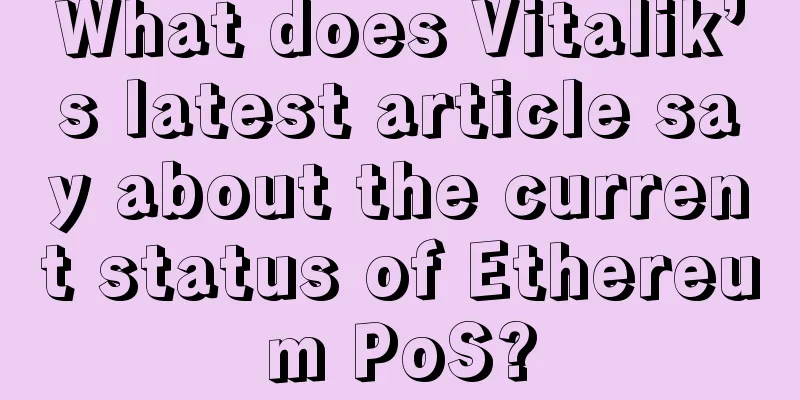What does Vitalik’s latest article say about the current status of Ethereum PoS?

|
Vitalik recently published an article titled "Protocols and Staking Pool Modifications to Improve Mainnet Decentralization and Reduce Consensus Layer Load". After the article was translated literally, it was terribly ambiguous and the title of the article was changed beyond recognition. I was forced to read the original English text, and now I share the summary with you: 1. Current Status of Ethereum PoS: Two-layer Staking The current status of Ethereum PoS is a two-tier staking system consisting of node operators and delegators. The two-tier staking system has two flaws: --The centralization risk of node operators . Staking pools that act as entrusting agents, such as Lido, Coinbase, HTX, etc., do not have a very decentralized mechanism for selecting node operators; --Unnecessary consensus layer load . Currently, Ethereum needs to verify ~800,000 signatures per epoch. If a single slot is deployed for final confirmation, a single slot will verify ~800,000 signatures. Since most of the ETH staked participates in the consensus through a delegated agent, such a large-scale signature does not enhance the decentralization and security of the Ethereum mainnet, but unnecessarily increases the consensus layer load. 2. How does the two-tier staking system work? This chapter takes Lido and Rocket Pool as examples to introduce how decentralized delegation agents work, that is, users entrust ETH to Lido and Rocket Pool, who then entrust it to node operators. Lido and Rocket Pool will each issue LST tokens to users as proof of equity. 3. The role of the agent In this chapter, Vitalik analyzes the The significance of the principal-agent role. Vitalik first assumed two models: --Model 1: Assuming Rocket Pool is the only agent with 100% market share, the upper limit of Slashing (fines for faults and negative behavior) is now reduced to 2 ETH, Rocket Pool's node operator deposit is reduced to 2 ETH, rETH's annualized rate of return is 3%, node operators' annualized rate of return is 4%, and the total supply of ETH is 100 million --Model 2: Assuming that there is no agent, the minimum deposit for staking is reduced to 2 ETH, the total staking amount is capped at 6.25 million ETH, and the annualized rate of return for node operators is 1% After calculation, under the above two models, the cost for malicious node operators to launch consensus attacks is 2.08 million ETH. And the change rate of the total supply ratio of Staking ETH and non-Staking ETH is also the same. Therefore, both from the perspective of staking economics and from the perspective of attack costs, the two models are completely equivalent. This seems to mean that the two-tier staking system is a meaningless Rube Goldberg machine. Vitalik believes that the principal should play a more meaningful role: --The entrustee selects the node operator. The entrusting agent can choose the node operator to perform Staking. When the node operator participates in the consensus, there will be a weight coefficient that determines the probability of it obtaining the right to produce a block, and this weight coefficient is proportional to the entrusted ETH obtained by the node operator. --Participate in the consensus layer. The agent will play a new role in the consensus layer. Running this role is lighter than running a full node, and it will not be slashed, and can withdraw funds at any time. 4. Expand the agent’s right of choice There are three ways to expand the agent's options: --Better Staking Pool voting tools. A typical example is the "LDO and stETH dual governance model" proposed by the Lido community. --Promote competition in the Staking Pool market. There are two methods that can be explored: one is to reduce the slashing limit to 2ETH or 4ETH to facilitate small Staking Pools; the other is to create a unified contract responsible for issuing LST Tokens, so that stETH, rETH, etc. will have the same security and adoptability. --Encapsulate the proxy into the protocol layer. In the future, the proxy may be encapsulated into the protocol layer. However, according to Ethereum’s principle of minimal encapsulation, whether to deploy this feature requires a lot of discussion before it can be confirmed. 5. Consensus layer participation This section involves a lot of technical details, so we won’t go into detail. In short, Vitalik envisions dividing the current consensus layer into two layers: --High complexity layer . Node operators run full nodes to participate, with higher staking rewards but slashing risks; this layer participates in consensus in every epoch and may set an upper limit of 10,000 nodes. --Low complexity layer . No need to run a full node, maybe 10,000 small stakers are randomly selected to participate in the consensus. They are completely exempt from Slashing penalties. Under this consensus layer architecture, consensus layer blocks need to be double-verified by the high-complexity layer and the low-complexity layer. 6. Reviews Vitalik and the Ethereum Foundation are somewhat unhappy about the current situation of Lido Staking Pool holding ~32% of the accounting rights of Ethereum POS. However, Rocket Pool, the incubated child, failed to live up to expectations and completely lost in the market competition with Lido, with a market share of only ~3%. After launching a round of public opinion and moral offensives some time ago in order to maintain the political correctness of the main network's decentralization, Lido chose to withstand the pressure and refused to set limits on itself, continuing to seize market share. In this case, in order to improve the decentralization of the main network and reduce the load on the consensus layer, making some necessary minimal modifications to the rules of the protocol and staking pool has become an option that they have to consider seriously. |
>>: Can you protect your rights when you suffer losses from Filecoin virtual currency mining?
Recommend
What is the best fortune for people with moles on their ring fingers?
Generally speaking, moles on the ring finger have...
Buck teeth face analysis: Does buck teeth affect the development of fortune?
We all want to have a set of neat and white teeth...
Palmistry of a Bad-Temperant Person
We have all had the experience of dealing with a ...
Mole location and destiny - what does it mean to have a mole around the belly button
People with moles on their belly buttons usually ...
Mole location and destiny - what does a mole on a man's leg mean
There are two different extremes when a man has a...
The fate of a man with linked eyebrows. Is the character of a man with linked eyebrows good?
In life, we see many eyebrow shapes, and differen...
Eyebrows fortune telling
1. Fortune telling based on straight eyebrows If ...
Re-examining blockchain from Satoshi Nakamoto’s white paper
Translation: Height difference signal is full As ...
FCH (FREECASH) will be listed on Huobi Exchange on February 21
Dear Tiger User: Huobi will launch the FCH/USDT t...
When Egyptian cotton meets blockchain
Rage Review : Indian textile manufacturer Welspun...
How will a man with a bulbous nose enjoy wealth and glory?
Is it good for a man to have a bulbous nose? A ga...
Detailed explanation of the bifurcation, number and length of the marriage line in palmistry
Marriage Line (1) Three branches extend from the ...
F2Pool Yilifang ETN Mining Tutorial
Currently, ETN can be mined through CPU, graphics...
What does a crooked mouth mean in physiognomy
People with crooked mouths will have a very affec...
Wu Kuanzhi teaches how to read the three major evil lines
Wu Kuanzhi teaches how to read the three major ev...









